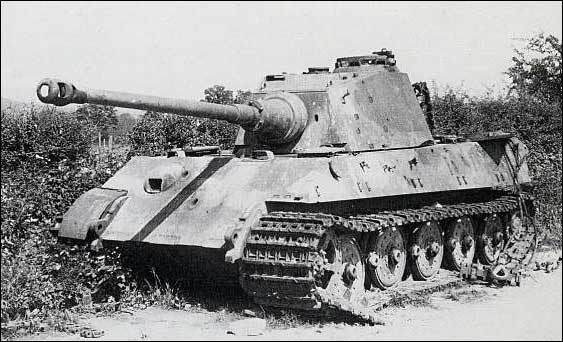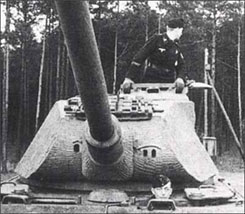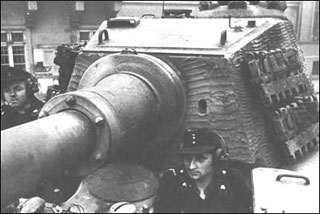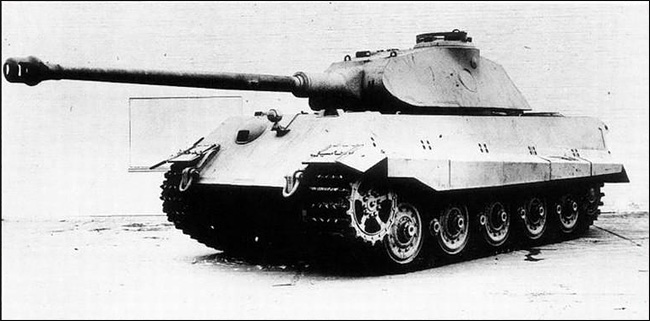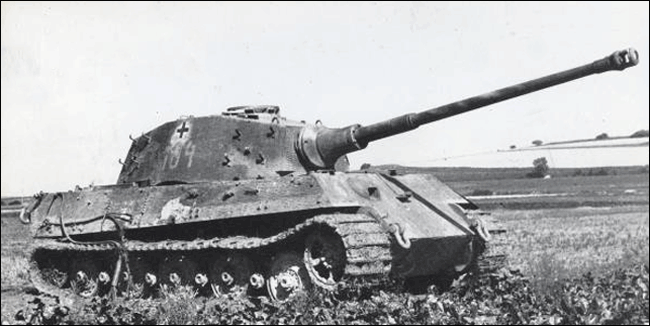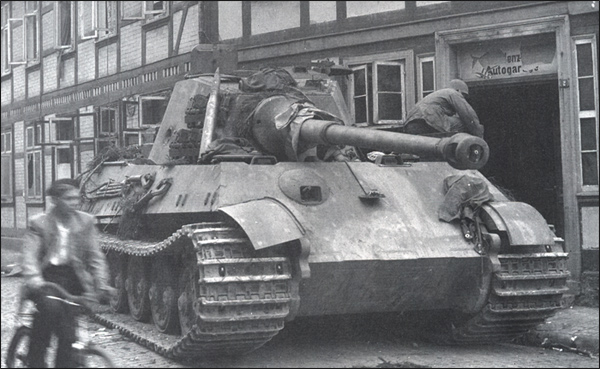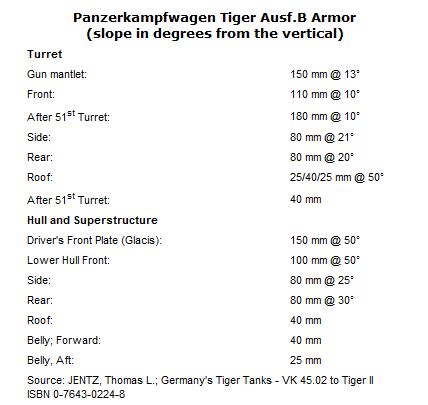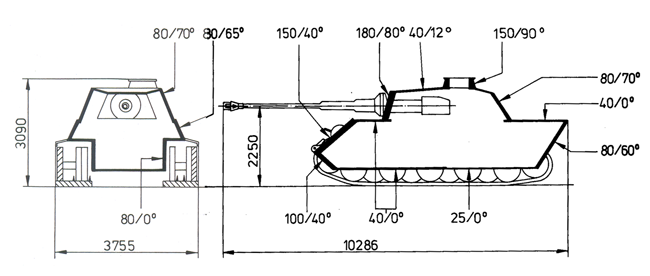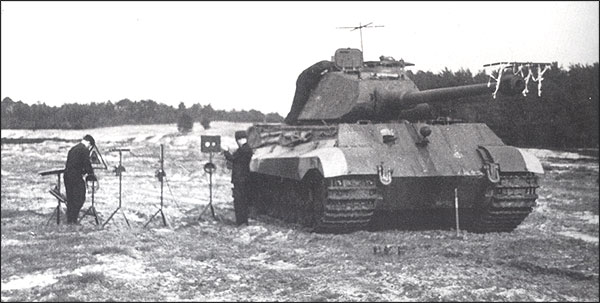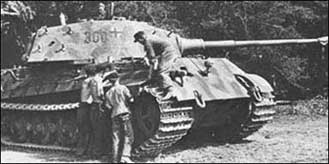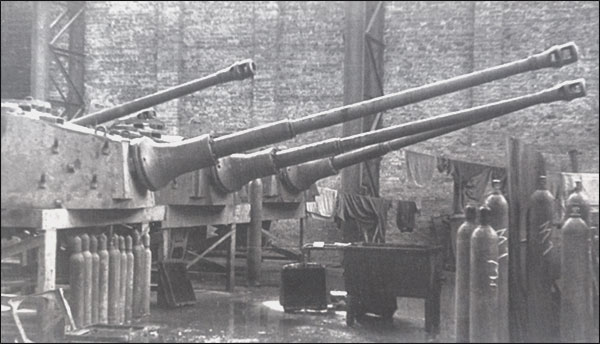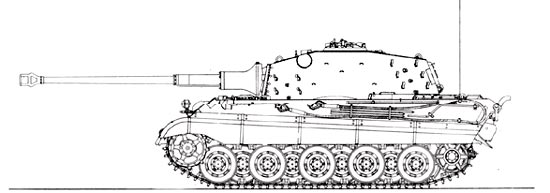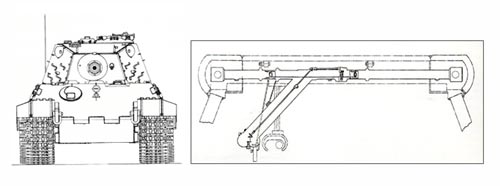Tiger II
| Revision as of 16:31, 9 February 2011 | Revision as of 17:36, 9 February 2011 | |||
| Line 68: | Line 68: | |||
| Once again, Porsche and Henschel were asked for designs which were to incorporate the latest sloped armor and the installation of the longer Rheinmetall 88 mm Flak 41. However, there was the sensitive question, for Krupp, of mounting an archrival's gun in their turret. Anyway, on 5 February 1943, Krupp was awarded the contract for the development of the 88 mm KwK 43 L/71, a new gun specifically designed to the successor of the Tiger I. The only similarity between this gun designed by Krupp and the Rheinmetall Flak 41 was that the same penetration values were achieved when the same shell was fired with the same initial muzzle velocity. All other characteristics of the two guns were different. Following the main specification to achieve equivalent armor penetration, Krupp completely redesigned the gun for mounting in a tank turret. As compared to the Flak 41 L/74, the KwK 43 L/71 was shorter with different rifling and had a muzzle brake to retard recoil. In addition it had shorter, fatter recoil cylinders to fit inside a turret, had an air blast system fitted to evacuate fumes from the gun directly after firing and chambered a shorter (but thicker) cartridge case for easier loading inside a turret. | Once again, Porsche and Henschel were asked for designs which were to incorporate the latest sloped armor and the installation of the longer Rheinmetall 88 mm Flak 41. However, there was the sensitive question, for Krupp, of mounting an archrival's gun in their turret. Anyway, on 5 February 1943, Krupp was awarded the contract for the development of the 88 mm KwK 43 L/71, a new gun specifically designed to the successor of the Tiger I. The only similarity between this gun designed by Krupp and the Rheinmetall Flak 41 was that the same penetration values were achieved when the same shell was fired with the same initial muzzle velocity. All other characteristics of the two guns were different. Following the main specification to achieve equivalent armor penetration, Krupp completely redesigned the gun for mounting in a tank turret. As compared to the Flak 41 L/74, the KwK 43 L/71 was shorter with different rifling and had a muzzle brake to retard recoil. In addition it had shorter, fatter recoil cylinders to fit inside a turret, had an air blast system fitted to evacuate fumes from the gun directly after firing and chambered a shorter (but thicker) cartridge case for easier loading inside a turret. | |||
| ? | + | [[image:PzKmpfVIB_image01.jpg|center|caption]] | ||
| ? | + | |||
| ? | + | |||
| == Krupp Turrets and Parts Standardization with the Panther II == | == Krupp Turrets and Parts Standardization with the Panther II == | |||
| Line 76: | Line 74: | |||
| Porsche updated its Tiger I design and this time was so sure of winning the contract, that it ordered a first batch of 50 turrets from Krupp. Unfortunately, the Porsche ideas of electric transmission were once again rejected, as the supplies of copper were too small, and the contract went one again to Henschel. However, since 50 early-style turrets had already been made, they were fitted to the first units produced. The curved front plate created a serious shot trap which deflected incoming rounds down into the driver's compartment. The bulge for the cupola also was a weak area in the turret side armor. Krupp then modified the turret, and the new design eliminated those deficiencies, was simpler and offered better protection while providing room for 6 more rounds of ammunition. The new Serien-Turm (series production turret) designed for the Tiger II had a 180 mm thick front plate, 80 mm sidewalls, and 40 mm roof. The gun mantlet was specifically designed to be immune to attack or being jammed. This new design did not create high explosive blast pockets and prevented deflections of projectiles down to the deck. The early-style turret is commonly referred to as the 'Porsche Turret'; and the series production turret, as the 'Henschel turret'. However, both turrets were designed and built by Krupp, and this classification leads to misunderstandings. It is best to call the fist 50 turrets "early-production turrets", and from the 51st on as "series production turrets" (Serien-Turm). | Porsche updated its Tiger I design and this time was so sure of winning the contract, that it ordered a first batch of 50 turrets from Krupp. Unfortunately, the Porsche ideas of electric transmission were once again rejected, as the supplies of copper were too small, and the contract went one again to Henschel. However, since 50 early-style turrets had already been made, they were fitted to the first units produced. The curved front plate created a serious shot trap which deflected incoming rounds down into the driver's compartment. The bulge for the cupola also was a weak area in the turret side armor. Krupp then modified the turret, and the new design eliminated those deficiencies, was simpler and offered better protection while providing room for 6 more rounds of ammunition. The new Serien-Turm (series production turret) designed for the Tiger II had a 180 mm thick front plate, 80 mm sidewalls, and 40 mm roof. The gun mantlet was specifically designed to be immune to attack or being jammed. This new design did not create high explosive blast pockets and prevented deflections of projectiles down to the deck. The early-style turret is commonly referred to as the 'Porsche Turret'; and the series production turret, as the 'Henschel turret'. However, both turrets were designed and built by Krupp, and this classification leads to misunderstandings. It is best to call the fist 50 turrets "early-production turrets", and from the 51st on as "series production turrets" (Serien-Turm). | |||
| ? | + | [[image:PzKmpfVIB_image02.jpg|left|caption]] [[image:PzKmpfVIB_image03.jpg|right|caption]] | ||
| + | ||||
| + | ||||
| + | ||||
| + | ||||
| + | ||||
| + | ||||
| + | ||||
| + | ||||
| + | ||||
| + | ||||
| + | ||||
| + | ||||
| + | ||||
| + | ||||
| + | ||||
| + | ||||
| + | ||||
| + | ||||
| + | ||||
| In February 1943, WaPrüf 6/III drew a requirement for an extensive unification of the specification in order to standardize as many parts as possible with the Panther II, which never went into production, and the subsequent delays caused the production to never reach the planned levels until December 1943. The PzKpfw. Tiger Ausf. B was a massive and formidable vehicle, designed to dominate the battlefield. The new hull design for the VK 45.03 (H) consisted of sloping plates for increased protection. The front glacis plate was 150 mm at 50°, front nose plate 100 mm at 50°, superstructure side plates 80 mm at 0° vertical, tail plate 80 mm at 30°, deck plates 40 mm at 90° horizontal, and rear belly plate 25 mm horizontal. Forty-eight rounds of ammunition for the main gun were stored horizontally in panniers on each side of the hull. The rounds were stowed in three groups, on both sides. Each group was separated by sliding metal panels. An additional ten to 16 rounds were stacked loose on the turret floor. | In February 1943, WaPrüf 6/III drew a requirement for an extensive unification of the specification in order to standardize as many parts as possible with the Panther II, which never went into production, and the subsequent delays caused the production to never reach the planned levels until December 1943. The PzKpfw. Tiger Ausf. B was a massive and formidable vehicle, designed to dominate the battlefield. The new hull design for the VK 45.03 (H) consisted of sloping plates for increased protection. The front glacis plate was 150 mm at 50°, front nose plate 100 mm at 50°, superstructure side plates 80 mm at 0° vertical, tail plate 80 mm at 30°, deck plates 40 mm at 90° horizontal, and rear belly plate 25 mm horizontal. Forty-eight rounds of ammunition for the main gun were stored horizontally in panniers on each side of the hull. The rounds were stowed in three groups, on both sides. Each group was separated by sliding metal panels. An additional ten to 16 rounds were stacked loose on the turret floor. | |||
| ? | + | [[image:PzKmpfVIB_image04.jpg|center|caption]] | ||
| The whole running gear was redesigned. For the first time, a staggered running gear with nine pairs of rubber-spring road wheels, of 800 mm diameter, was used on each side. These road wheels consisted of two strong sheet steel rims attached to a wheel disk of steel between two rubber rings under very high pressure. The drive sprocket was similar to that of the Tiger I, but were built more strongly. The road wheel cranks were single drop-forged pieces and much strenghtened. The crank arrangement resembled those of the Panther without rubber, but with layered conical springs. Compared to the Tiger I, the torsion bars were strenghtened and fitted with toothed heads. They no longer differed in diameter, so they could not be fine tuned. The combat tracks, which weighed 3.2 tons each, were 800 mm wide thus providing an acceptable ground pressure (when the tracks sunk to 20 cm) of 0.76 kilograms per square centimeter. Once again, loading tracks, 600 mm wide, had to be used for rail transportation. The combat weight of the vehicle was 68.5 metric tons. | The whole running gear was redesigned. For the first time, a staggered running gear with nine pairs of rubber-spring road wheels, of 800 mm diameter, was used on each side. These road wheels consisted of two strong sheet steel rims attached to a wheel disk of steel between two rubber rings under very high pressure. The drive sprocket was similar to that of the Tiger I, but were built more strongly. The road wheel cranks were single drop-forged pieces and much strenghtened. The crank arrangement resembled those of the Panther without rubber, but with layered conical springs. Compared to the Tiger I, the torsion bars were strenghtened and fitted with toothed heads. They no longer differed in diameter, so they could not be fine tuned. The combat tracks, which weighed 3.2 tons each, were 800 mm wide thus providing an acceptable ground pressure (when the tracks sunk to 20 cm) of 0.76 kilograms per square centimeter. Once again, loading tracks, 600 mm wide, had to be used for rail transportation. The combat weight of the vehicle was 68.5 metric tons. | |||
| ? | + | [[image:PzKmpfVIB_image05.png|center|caption]] | ||
| The Panzerkampfwagen Tiger Ausf. B powerplant was the Maybach HL 230 P 30, a 12-cylinder engine also used on the Panther, producing 700 HP at 3,000 rpm, through an 8-speed Maybach transmission, designed to provide a maximum speed of 41.5 km/h. The OLVAR gearbox required a shifting process that was just like that of a manual transmission with power interruption. Its trouble free operation depended largely on the ability and calm (even in combat) of the driver. However, the easily shifted OLVAR gearbox and easily steered two-radius steering gear definitely improved the driver's job. | The Panzerkampfwagen Tiger Ausf. B powerplant was the Maybach HL 230 P 30, a 12-cylinder engine also used on the Panther, producing 700 HP at 3,000 rpm, through an 8-speed Maybach transmission, designed to provide a maximum speed of 41.5 km/h. The OLVAR gearbox required a shifting process that was just like that of a manual transmission with power interruption. Its trouble free operation depended largely on the ability and calm (even in combat) of the driver. However, the easily shifted OLVAR gearbox and easily steered two-radius steering gear definitely improved the driver's job. | |||
| Line 120: | Line 137: | |||
| == Armor Protection == | == Armor Protection == | |||
| ? | + | [[image:PzKmpfVIB_image06.jpg|center|caption]] | ||
| The frontal armor of the Tiger II provided the best protection possible - the front turret was 180 mm inclined at 10 degrees from the vertical, compounded with a special designed mantlet, which was immune to penetration and being jammed. The glacis plate was a 150 mm thick plate inclined at 50 degrees from vertical, so the actual protection given by the armor plate inclination was more than 230 mm. There is no proof that this frontal armor was ever penetrated in combat, even though the British 17 Pounder, when using a special APDS ammunition, could theoretically penetrate the Tiger II front armor (front turret and lower front hull, only - the 17 Pounder could not penetrate the Tiger II glacis plate), but those APDS rounds were terribly inaccurate and had a tendency of ricochet off inclined armor such as was the lower front hull (100 mm inclined at 50 degrees from the vertical) of the Tiger II. Even the side and rear armor protection was sufficient to eliminate any serious threat from the American 75 mm or the Russian 76 mm tanks guns. The hull was welded, as was that of the Tiger I, but the armor was better sloped, using the experience of the T-34. Hull layout was similar to that of the Panther, and the large turret was roomy although the gun came right back to the rear wall and made a complete partition longitudinally. The thickness and angles of the armor protection are shown in the Table below : | The frontal armor of the Tiger II provided the best protection possible - the front turret was 180 mm inclined at 10 degrees from the vertical, compounded with a special designed mantlet, which was immune to penetration and being jammed. The glacis plate was a 150 mm thick plate inclined at 50 degrees from vertical, so the actual protection given by the armor plate inclination was more than 230 mm. There is no proof that this frontal armor was ever penetrated in combat, even though the British 17 Pounder, when using a special APDS ammunition, could theoretically penetrate the Tiger II front armor (front turret and lower front hull, only - the 17 Pounder could not penetrate the Tiger II glacis plate), but those APDS rounds were terribly inaccurate and had a tendency of ricochet off inclined armor such as was the lower front hull (100 mm inclined at 50 degrees from the vertical) of the Tiger II. Even the side and rear armor protection was sufficient to eliminate any serious threat from the American 75 mm or the Russian 76 mm tanks guns. The hull was welded, as was that of the Tiger I, but the armor was better sloped, using the experience of the T-34. Hull layout was similar to that of the Panther, and the large turret was roomy although the gun came right back to the rear wall and made a complete partition longitudinally. The thickness and angles of the armor protection are shown in the Table below : | |||
| ? | + | [[image:PzKmpfVIB_image07.png|center|caption]] | ||
| + | ||||
| + | [[image:PzKmpfVIB_image08.png|center|caption]] | |||
| == Firepower == | == Firepower == | |||
| ? | + | [[image:PzKmpfVIB_image09.jpg |left|caption]] | ||
| The long and powerful 88 mm KwK 43 L/71 gun could outrange and outshoot the main armament of nearly all Allied tanks, and this allowed the Tiger II to stand off and engage targets as it choose. Besides that, the 88 mm KwK 43 L/71 was a very accurate gun, being capable of first round hits at well over 1000 meters. Given its high muzzle velocity, the barrel wear was a difficulty with this gun, but this was solved by building the barrel in two sections, so it was possible to change the faster wearing part easily. | The long and powerful 88 mm KwK 43 L/71 gun could outrange and outshoot the main armament of nearly all Allied tanks, and this allowed the Tiger II to stand off and engage targets as it choose. Besides that, the 88 mm KwK 43 L/71 was a very accurate gun, being capable of first round hits at well over 1000 meters. Given its high muzzle velocity, the barrel wear was a difficulty with this gun, but this was solved by building the barrel in two sections, so it was possible to change the faster wearing part easily. | |||
| Line 190: | Line 209: | |||
| == Movility == | == Movility == | |||
| ? | + | [[image:PzKmpfVIB_image10.jpg.jpg |left|caption]] [[image:PzKmpfVIB_image11.jpg|right|caption]] | ||
| Numerous statements have been made that the Tiger II was too heavy, too big, too slow, "a casemate", etc. One is left with the impression that it was lucky to move at all. These banal generalities, stated as incontrovertible facts, are never substantiated by actual specifications, test reports or after-action accounts from the units that used the Tiger II. In spite of these frequently repeated remarks, the capability of the Tiger II to negotiate obstacles and cross terrain was equivalent to or better than most German and allied tanks | Numerous statements have been made that the Tiger II was too heavy, too big, too slow, "a casemate", etc. One is left with the impression that it was lucky to move at all. These banal generalities, stated as incontrovertible facts, are never substantiated by actual specifications, test reports or after-action accounts from the units that used the Tiger II. In spite of these frequently repeated remarks, the capability of the Tiger II to negotiate obstacles and cross terrain was equivalent to or better than most German and allied tanks | |||
| Line 199: | Line 218: | |||
| == Production == | == Production == | |||
| ? | + | [[image:PzKmpfVIB_image12.jpg|middle|caption]] | ||
| Following an initial order for Three prototype chassis, an initial production series of 176 Tiger II was ordered in October 1942. Following cancellation of the Porsche Tigers in November 1942, the contract (with Henschel) was quickly expanded by an additional 350. Later extensions to the contracts increased the total order to over 1500. In accordance with the original production plans from October 1942, the first Tiger II was to be completed in September 1943. The number produced each month was to be expanded to reach a target of 50 per month in May 1944. This production schedule satisfied the Inpekteur der Panzertruppen who wanted 100 Tiger II available for a spring offensive in 1944. Due to delays, the first prototype V1 was accepted by Waffenamt inspector in November 1943. Two further prototypes, V2 and V3, and the first three production series Tiger II were accepted in January 1944. The production run continued through March 1945 for a total of three prototypes and 489 production series Tiger II produced by Henschel. | Following an initial order for Three prototype chassis, an initial production series of 176 Tiger II was ordered in October 1942. Following cancellation of the Porsche Tigers in November 1942, the contract (with Henschel) was quickly expanded by an additional 350. Later extensions to the contracts increased the total order to over 1500. In accordance with the original production plans from October 1942, the first Tiger II was to be completed in September 1943. The number produced each month was to be expanded to reach a target of 50 per month in May 1944. This production schedule satisfied the Inpekteur der Panzertruppen who wanted 100 Tiger II available for a spring offensive in 1944. Due to delays, the first prototype V1 was accepted by Waffenamt inspector in November 1943. Two further prototypes, V2 and V3, and the first three production series Tiger II were accepted in January 1944. The production run continued through March 1945 for a total of three prototypes and 489 production series Tiger II produced by Henschel. | |||
| Line 208: | Line 227: | |||
| == The Tiger II and Entfernungsmesser (Range Finder) Development == | == The Tiger II and Entfernungsmesser (Range Finder) Development == | |||
| ? | + | [[image:PzKmpfVIB_image13.jpg|middle|caption]] | ||
| The war in North Africa and in the large plains of Russia had shown that range measurement in wide areas such as the desert or the Russian steppes would be most useful, as guessing the range could be misleading. When the tank halts before firing and the range to the target is under 1000 meters, the elevation of a high velocity gun such as the 88mm KwK 43 L/71 (whose muzzle velocity was equal or more than 1,000 m/s) is not affected much by range, and range measurements can be dispensed with. The great advantage of using a range finder lies in the possibility of opening fire at longer ranges. Without the range finder, precious time and ammunition were lost when the elevation of the gun must be corrected by observing the effect of fire. | The war in North Africa and in the large plains of Russia had shown that range measurement in wide areas such as the desert or the Russian steppes would be most useful, as guessing the range could be misleading. When the tank halts before firing and the range to the target is under 1000 meters, the elevation of a high velocity gun such as the 88mm KwK 43 L/71 (whose muzzle velocity was equal or more than 1,000 m/s) is not affected much by range, and range measurements can be dispensed with. The great advantage of using a range finder lies in the possibility of opening fire at longer ranges. Without the range finder, precious time and ammunition were lost when the elevation of the gun must be corrected by observing the effect of fire. | |||
| ? | + | [[image:PzKmpfVIB_image14.jpg|left|caption]] | ||
| As the tank commander was preoccupied with other tasks, the gunner would take charge of the range finder. After locating the target with the periscope and aligning the target in the sight, the gunner operates the range finder, reads the range, and adjusts the range scale to the correct range which provides the additional elevation associated with the range. The range scale was seen at the bottom of the field of the right eyepiece. It was graduated in meters from 550 to 20,000. | As the tank commander was preoccupied with other tasks, the gunner would take charge of the range finder. After locating the target with the periscope and aligning the target in the sight, the gunner operates the range finder, reads the range, and adjusts the range scale to the correct range which provides the additional elevation associated with the range. The range scale was seen at the bottom of the field of the right eyepiece. It was graduated in meters from 550 to 20,000. | |||
Revision as of 17:36, 9 February 2011
 |
This page is a work in progress, Rahxephonroh was editing it and left halfway through so please do not edit it until it is marked as complete before you contact the user or enough time as passed for the page to be considered abandoned. Use the Discussion page for any relevant input you might have please. |
This warning was posted at: 20:54, 8 February 2011 (UTC)
PzKpfw VIB Tiger II
| Germany | Heavy Tank | Tier VIII |
| Cost | 2,392,000 |
|---|---|
| Health | 1,400 |
| Weight/Load Limit | 67.25/68.5t |
| Engine Power | 650hp |
| Speed Limit | 28km/h |
| Traverse Speed | 23deg/s |
| Hull Armor | 150/80/80mm |
| Turret Armor | 100/80/80mm |
| Damage | 165-275HP |
| Penetration | 152-254mm |
| Rate of Fire | 8.96r/m |
| Accuracy | 0.3m |
| Aim time | 2.5s |
| Turret Traverse | 34deg/s |
| Gun Traverse Arc | gunTraverseArc |
| Gun Vertical Limits | gunVerticalLimits |
| Ammo Capacity | ammo |
| Chance of Fire | 20% |
| View Range | 460m |
| Signal Range | 470m |
| Parent | parent |
| Child | child |
PzKpfw VIB Tiger II Also knows as the King Tiger, Königstiger or KT in-game, this is the tier 8 heavy tank of the Germans Tech Tree, it unlocks the VK 4502 (P) Ausf.B. For now you have one of the most feared tanks in the Second World War in your hands, it's a very good tank even in stock configuration, you will note a high performance when you're driving this Heavy tank, lots of enemy shells richochet or bounce off when they hit the tank and it have a good mobility, usually you will be in high class combats when you're using this armored vehicle, and in most of them you will be the first of the list, just like his predecesor this tank is a sniping tank with good accuracy and a great range of fire, with the short and large 105mm cannons you will be able to hit the enemy harder than before, it's the counterpart of the IS-3 and the T32 heavy tanks, so you need to remember that you're not the only one who is driving a great tank, try to avoid close combat and support the advance of your own team, if for some reason you're suddenly involved in a close combat fight don't be affraid, with this tank you can hold a position for a good time while you're waiting for reinforcements. Welcome to one of the most powerful tanks of the German army on this game. Play smartly with it and you will be the king of the battlefield.
Modules
|
Historical Info
The German point of view was that, at the rate of evolution the armored warfare was occurring, superiority could only be maintained by one year, at maximum. Things being as they were in early 1943, the Tiger I and the Panther would be enough, but in order to preserve the superiority in 1944, a new heavy tank would be necessary. On January 1943, Hitler decided that the new Tiger would have the longer Rheinmetall 88 mm Flak 41, and to have 150 mm of front armor and 80 mm of side armor - the inclination of the armor plates resulted that the new tank looked very similar to the PzKpfw. V Panther.
Once again, Porsche and Henschel were asked for designs which were to incorporate the latest sloped armor and the installation of the longer Rheinmetall 88 mm Flak 41. However, there was the sensitive question, for Krupp, of mounting an archrival's gun in their turret. Anyway, on 5 February 1943, Krupp was awarded the contract for the development of the 88 mm KwK 43 L/71, a new gun specifically designed to the successor of the Tiger I. The only similarity between this gun designed by Krupp and the Rheinmetall Flak 41 was that the same penetration values were achieved when the same shell was fired with the same initial muzzle velocity. All other characteristics of the two guns were different. Following the main specification to achieve equivalent armor penetration, Krupp completely redesigned the gun for mounting in a tank turret. As compared to the Flak 41 L/74, the KwK 43 L/71 was shorter with different rifling and had a muzzle brake to retard recoil. In addition it had shorter, fatter recoil cylinders to fit inside a turret, had an air blast system fitted to evacuate fumes from the gun directly after firing and chambered a shorter (but thicker) cartridge case for easier loading inside a turret.
Krupp Turrets and Parts Standardization with the Panther II
Porsche updated its Tiger I design and this time was so sure of winning the contract, that it ordered a first batch of 50 turrets from Krupp. Unfortunately, the Porsche ideas of electric transmission were once again rejected, as the supplies of copper were too small, and the contract went one again to Henschel. However, since 50 early-style turrets had already been made, they were fitted to the first units produced. The curved front plate created a serious shot trap which deflected incoming rounds down into the driver's compartment. The bulge for the cupola also was a weak area in the turret side armor. Krupp then modified the turret, and the new design eliminated those deficiencies, was simpler and offered better protection while providing room for 6 more rounds of ammunition. The new Serien-Turm (series production turret) designed for the Tiger II had a 180 mm thick front plate, 80 mm sidewalls, and 40 mm roof. The gun mantlet was specifically designed to be immune to attack or being jammed. This new design did not create high explosive blast pockets and prevented deflections of projectiles down to the deck. The early-style turret is commonly referred to as the 'Porsche Turret'; and the series production turret, as the 'Henschel turret'. However, both turrets were designed and built by Krupp, and this classification leads to misunderstandings. It is best to call the fist 50 turrets "early-production turrets", and from the 51st on as "series production turrets" (Serien-Turm).
In February 1943, WaPrüf 6/III drew a requirement for an extensive unification of the specification in order to standardize as many parts as possible with the Panther II, which never went into production, and the subsequent delays caused the production to never reach the planned levels until December 1943. The PzKpfw. Tiger Ausf. B was a massive and formidable vehicle, designed to dominate the battlefield. The new hull design for the VK 45.03 (H) consisted of sloping plates for increased protection. The front glacis plate was 150 mm at 50°, front nose plate 100 mm at 50°, superstructure side plates 80 mm at 0° vertical, tail plate 80 mm at 30°, deck plates 40 mm at 90° horizontal, and rear belly plate 25 mm horizontal. Forty-eight rounds of ammunition for the main gun were stored horizontally in panniers on each side of the hull. The rounds were stowed in three groups, on both sides. Each group was separated by sliding metal panels. An additional ten to 16 rounds were stacked loose on the turret floor.
The whole running gear was redesigned. For the first time, a staggered running gear with nine pairs of rubber-spring road wheels, of 800 mm diameter, was used on each side. These road wheels consisted of two strong sheet steel rims attached to a wheel disk of steel between two rubber rings under very high pressure. The drive sprocket was similar to that of the Tiger I, but were built more strongly. The road wheel cranks were single drop-forged pieces and much strenghtened. The crank arrangement resembled those of the Panther without rubber, but with layered conical springs. Compared to the Tiger I, the torsion bars were strenghtened and fitted with toothed heads. They no longer differed in diameter, so they could not be fine tuned. The combat tracks, which weighed 3.2 tons each, were 800 mm wide thus providing an acceptable ground pressure (when the tracks sunk to 20 cm) of 0.76 kilograms per square centimeter. Once again, loading tracks, 600 mm wide, had to be used for rail transportation. The combat weight of the vehicle was 68.5 metric tons.
The Panzerkampfwagen Tiger Ausf. B powerplant was the Maybach HL 230 P 30, a 12-cylinder engine also used on the Panther, producing 700 HP at 3,000 rpm, through an 8-speed Maybach transmission, designed to provide a maximum speed of 41.5 km/h. The OLVAR gearbox required a shifting process that was just like that of a manual transmission with power interruption. Its trouble free operation depended largely on the ability and calm (even in combat) of the driver. However, the easily shifted OLVAR gearbox and easily steered two-radius steering gear definitely improved the driver's job.
Official Designation
Thomas L. Jentz, in "Germany's Tiger Tanks: Vol.2 - VK 45.02 to Tiger II" (Schiffer, 1998), presents a list of official names given to the Tiger II, ordered by date, from 1942 to 1943:
Wa Prüf 6 Designations:
VK 45.02 (H) 15 April 1942
Tiger II for the VK 45.02 (H) 18 September 1942
Tiger III (VK 45.03) 12 October 1942
Henschel Tiger B 08 January 1943
Tiger II for the VK 45.03 03 March 1943
Pz.Kpfw. Tiger Ausf B 02 June 1943
Pz.Bef.Wg.Tiger Ausf.B 02 June 1943
The official designations were Panzerkampfwagen Tiger Ausf. B and Panzerbefehlswagen Tiger Ausf. B (for the command version), which originated in a WaPrüf 6 (Waffenprüfamter 6 - Weapons Development and Testing Department - "6" being the number that corresponded to "Tanks and other Vehicles") order dated 2 June 1943. The official designation was frequently shortened to Tiger B. The full titles Panzerkampfwagen Tiger (8,8 cm Kw.K. L/71) (Sd.Kfz. 182), and Panzerbefehlswagen Tiger (Sd.Kfz. 267 und 268) Ausf. B were specified by the Inspecteur der Panzertruppen (In6) for use in training and maintenance manuals, as well as in the K.St.N. (organization and equipment tables). The suggestive name Königstiger (King Tiger) was an unofficial designation first used by the Reichsministerium für Bewaffnung und Munition, in 11 December 1944. This was never an officially accepted designation during the war by either the Panzertruppen or the Waffenamt.
Armor Protection
The frontal armor of the Tiger II provided the best protection possible - the front turret was 180 mm inclined at 10 degrees from the vertical, compounded with a special designed mantlet, which was immune to penetration and being jammed. The glacis plate was a 150 mm thick plate inclined at 50 degrees from vertical, so the actual protection given by the armor plate inclination was more than 230 mm. There is no proof that this frontal armor was ever penetrated in combat, even though the British 17 Pounder, when using a special APDS ammunition, could theoretically penetrate the Tiger II front armor (front turret and lower front hull, only - the 17 Pounder could not penetrate the Tiger II glacis plate), but those APDS rounds were terribly inaccurate and had a tendency of ricochet off inclined armor such as was the lower front hull (100 mm inclined at 50 degrees from the vertical) of the Tiger II. Even the side and rear armor protection was sufficient to eliminate any serious threat from the American 75 mm or the Russian 76 mm tanks guns. The hull was welded, as was that of the Tiger I, but the armor was better sloped, using the experience of the T-34. Hull layout was similar to that of the Panther, and the large turret was roomy although the gun came right back to the rear wall and made a complete partition longitudinally. The thickness and angles of the armor protection are shown in the Table below :
Firepower
The long and powerful 88 mm KwK 43 L/71 gun could outrange and outshoot the main armament of nearly all Allied tanks, and this allowed the Tiger II to stand off and engage targets as it choose. Besides that, the 88 mm KwK 43 L/71 was a very accurate gun, being capable of first round hits at well over 1000 meters. Given its high muzzle velocity, the barrel wear was a difficulty with this gun, but this was solved by building the barrel in two sections, so it was possible to change the faster wearing part easily. The tables below represent the penetration capability of penetrating armor at an angle of 30 degrees from the vertical, and the probability of hitting a target representing the front of a tank.
During World War II, the Armor Piercing (AP) round relied on its own weight to penetrate the enemy's armor. The higher the muzzle velocity, the more penetration any kind of AP round would have, all other variables remaining constant. The Armor Piercing Capped, Ballistic Capped (APCBC) round relied not only on its own weight to penetrate the enemy's armor, but was also filled with high explosive that caused great internal damage. The Armor Piercing Composite Rigid (APCR) round was made with a tungsten core. For flight performance effects and to aid the shot from shattering against armor plating, the APCR round was surrounded by a ballistic cap. The HEAT round, which was based on the hollow charge principle, used a directed explosion, rather than mass or weight, to penetrate armor. The explosion is channeled forward into a stream, which cuts through armor, melting it along the way and including it in the stream.
The designation 88 mm KwK 43 L/71 means that the diameter of the bore (caliber) of this gun is 88 mm; this is a Tank Gun (Kampfwagenkanone); that the year the development of this gun was finalized was 1943; and that the length of the gun equals 71 times the diameter of the bore (caliber) of the same gun. This was the main gun installed on the Tiger II. Of the total ammunition load of 86 rounds (80 for the Tiger II with "early-style" turrets), the recommended ratio was 50% Pzgr.39/43 (APCBC) and 50% Sprgr. (high-explosive shells). The Gr 39/3 HL (HEAT) were rarely used. When available, but very rarely due to a severe shortage, a few Pzgr.40/43 (APCR) rounds were carried for use against the heaviest armored Russian tanks and tank destroyers.
Accuracy of the 88 mm KwK 43 L/71
| Range | ||||||||||
|---|---|---|---|---|---|---|---|---|---|---|
| Ammo | 100m | 500m | 1000m | 1500m | 2000m | 2500m | 3000m | 3500m | 4000m | |
| PzGr. 39/43 | 100%/100% | 100%/100% | 100%/85% | 95%/61% | 85%/43% | 74%/30% | 61%/23% | 51%/17% | 42%/13% | |
| PzGr. 40/43 | 100%/100% | 100%/100% | 100%/89% | 97%/66% | 89%/47% | 78%/34% | 66%/25% | --%/--% | --%/--% |
The sights for most of the Tigers II that actually saw combat was the articulated, monocular Turmzielfernrohr 9d mounted parallel and on the same axis as the main gun. The gunner could select two magnifications, 2.5x and 5x. The lower magnification provided a wider field of view for target identification. The higher magnification assisted in precise aiming at long ranges. Two adjustable range scales allowed the gunner to register the exact range to the target. The range scale for the Pzgr.39/43 was graduated at 100 m intervals out to a range of 4000 m and the second range scale for the Sprgr.43 was graduated out to a range of 6000 m.
Movility
Numerous statements have been made that the Tiger II was too heavy, too big, too slow, "a casemate", etc. One is left with the impression that it was lucky to move at all. These banal generalities, stated as incontrovertible facts, are never substantiated by actual specifications, test reports or after-action accounts from the units that used the Tiger II. In spite of these frequently repeated remarks, the capability of the Tiger II to negotiate obstacles and cross terrain was equivalent to or better than most German and allied tanks
The Tiger II initially experienced numerous automotive problems which required a continuous series of minor modifications to correct. These problems can be traced to two main causes: leaking seals and gaskets and an over taxed drive train originally designed for a 40 metric ton vehicle. The problem of keeping a Tiger II in running condition was compounded by a shortage of skilled drivers many of whom may have never experienced driving any vehicle prior to entering the service. In addition they were provided only limited driver's training, and then usually on a different type of panzer, and received their own Tiger II usually within a few days before being shipped to the front. But, with mature drivers, taking required maintenance halts, and modification of key automotive components, the Tiger II could be maintained in a satisfactory operational condition. Status reports from the Western Front, dated March 1945, showed that the percentage of Tigers operational at the Front was about equal to the PzKpfw IV and as good as or better than the Panther.
Production
Following an initial order for Three prototype chassis, an initial production series of 176 Tiger II was ordered in October 1942. Following cancellation of the Porsche Tigers in November 1942, the contract (with Henschel) was quickly expanded by an additional 350. Later extensions to the contracts increased the total order to over 1500. In accordance with the original production plans from October 1942, the first Tiger II was to be completed in September 1943. The number produced each month was to be expanded to reach a target of 50 per month in May 1944. This production schedule satisfied the Inpekteur der Panzertruppen who wanted 100 Tiger II available for a spring offensive in 1944. Due to delays, the first prototype V1 was accepted by Waffenamt inspector in November 1943. Two further prototypes, V2 and V3, and the first three production series Tiger II were accepted in January 1944. The production run continued through March 1945 for a total of three prototypes and 489 production series Tiger II produced by Henschel.
Only one model was built, and despite the heavy Allied bombing, Henschel always had at least 60 vehicles being assembled on its tank assembly line floors at any time. At the peak it was taking only 14 days to complete a Tiger II. Severe fuel shortages and heavy Allied bombing forced the factory to use bottled gas for testing, as all available fuel were supplied for operations.
The Tiger II and Entfernungsmesser (Range Finder) Development
The war in North Africa and in the large plains of Russia had shown that range measurement in wide areas such as the desert or the Russian steppes would be most useful, as guessing the range could be misleading. When the tank halts before firing and the range to the target is under 1000 meters, the elevation of a high velocity gun such as the 88mm KwK 43 L/71 (whose muzzle velocity was equal or more than 1,000 m/s) is not affected much by range, and range measurements can be dispensed with. The great advantage of using a range finder lies in the possibility of opening fire at longer ranges. Without the range finder, precious time and ammunition were lost when the elevation of the gun must be corrected by observing the effect of fire.
As the tank commander was preoccupied with other tasks, the gunner would take charge of the range finder. After locating the target with the periscope and aligning the target in the sight, the gunner operates the range finder, reads the range, and adjusts the range scale to the correct range which provides the additional elevation associated with the range. The range scale was seen at the bottom of the field of the right eyepiece. It was graduated in meters from 550 to 20,000.
On 28 February 1945, the armor manufacturers were asked when turrets modified to mount the Entfernungsmesser (range finders) would be produced . It was stated that they should strive to complete their first turret by 31 March and Krupp planned to start by mid July 1945. Therefore, the effort was initiated too late to complete any Tigers II with range finders, before the factory in Kassel fell into the hands of Allied troops (JENTZ, Thomas L.; Germany's TIGER Tanks - Tiger I and II: Combat Tactics; op. cit.).





